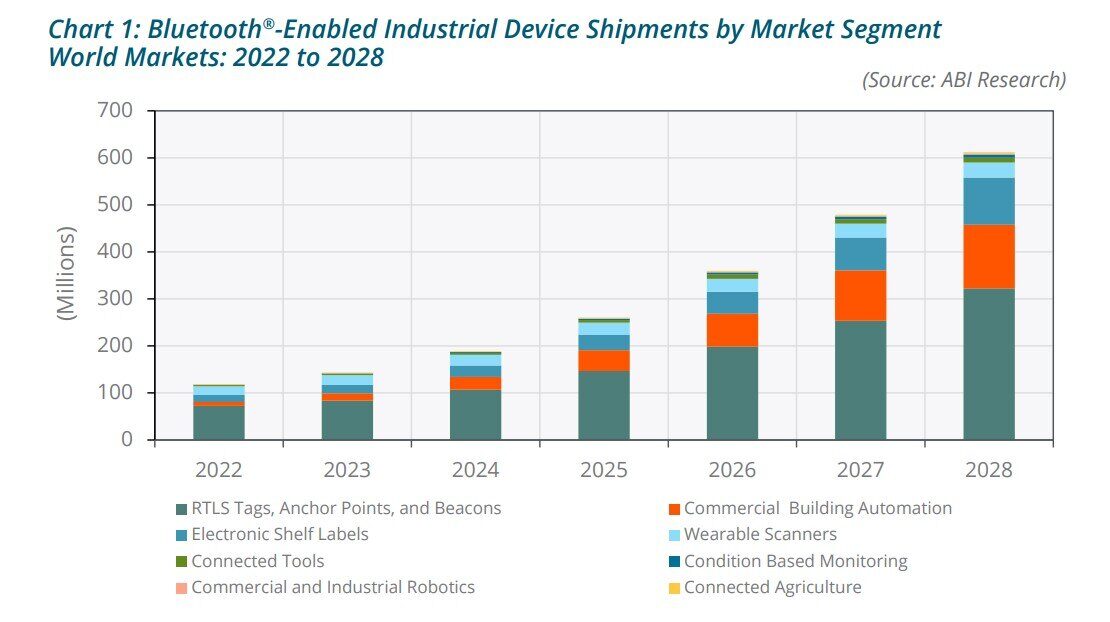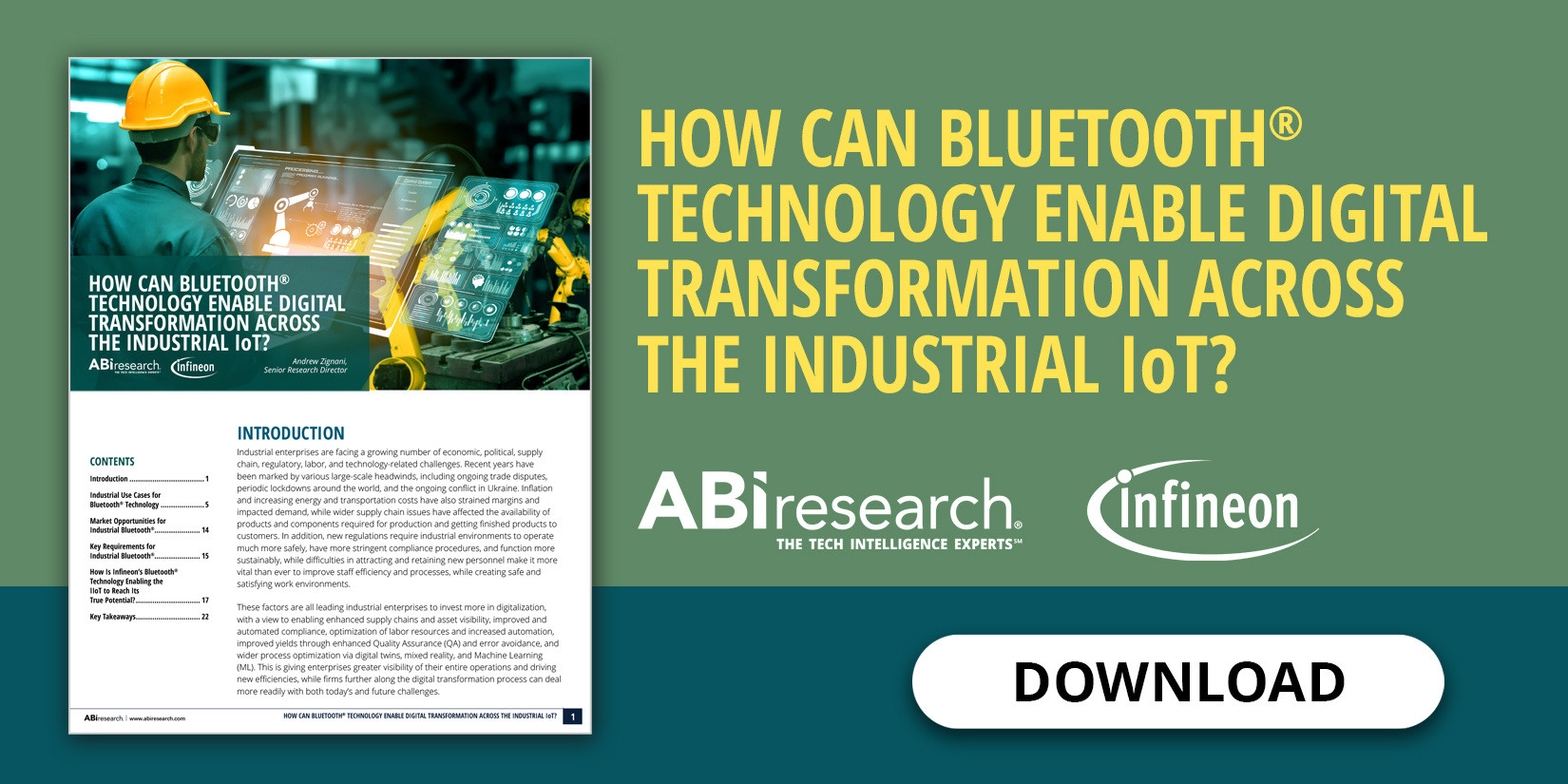Digital transformation is synonymous with the widespread use of connected devices (Industrial Internet of Things (IIoT) within an industrial environment. In many cases, enterprises will seek to enable connectivity of these IIoT devices with low-cost, low-powered solutions capable of being deployed at scale. For these reasons, Bluetooth® technology is increasingly essential in digitalizing factories, warehouses, smart buildings, farms, hospitals, retail stores, mining sites, and other enterprise settings. The wireless technology facilitates various industrial applications by providing short-range communication capabilities. ABI Research forecasts more than 600 million annual shipments of Bluetooth®-enabled industrial devices by 2028, nearly a six-fold increase from 2022.

Benefits of Bluetooth® for Digital Transformation
Industrial digital transformation encompasses a plethora of technology applications, each with unique connectivity requirements and environment topologies. Many of these industrial applications require Short-Range Wireless (SRW) connectivity, which is where Bluetooth® comes into play. Bluetooth® will often be combined with other wireless technologies to cater to a diverse range of scenarios. Some of the standout benefits of Bluetooth® for industrial companies include the following:
- Robustness
- High data rates
- Ultra-low power consumption via Bluetooth® Low Energy (LE)
- Ample availability of low-cost chipsets and modules
- Omnipresence in mobile and computing devices
- Strong presence in enterprise wireless infrastructure and IoT gateways
- Support for various topologies
- Accurate positioning
- Secure ranging capabilities
Bluetooth® solutions can be divided into two camps: 1) Bluetooth® Basic Rate/Enhanced Rate (BR/ER), also known as Bluetooth® Classic; and 2) Bluetooth® LE. Bluetooth® Classic has been useful in some industrial applications over the years; however, the technology has shown its age. Industrial firms are adopting increasingly advanced technologies, requiring more sophisticated SRW solutions. To overcome these challenges, Bluetooth® LE was developed, bringing new feature upgrades every year. Some of these features will be discussed in this article.
Industrial Applications of Bluetooth®
The rest of this article looks at five promising applications of Bluetooth® for industrial companies.
1.) Building Sensors
Smart buildings—including factory floors—deploy hundreds or even thousands of sensors on-premises to monitor numerous variables, such as temperature, humidity, vibration, pressure, flow, moisture, tilt, and acoustics of industrial equipment. These sensors are often deployed in remote areas or in tough environments that struggle with connectivity. Bluetooth® solutions from Infineon, for example, provide extended range capabilities, strong Radio Frequency (RF) performance, ultra-low power consumption, extended temperature range, and support for Periodic Advertising with Response (PAwR). Such connectivity technologies are scalable and cost-effective for sensorization applications, which is attractive for industrial operators.
Bluetooth® is also key for optimizing Heating, Ventilation, and Air Conditioning (HVAC), with central controllers communicating with Bluetooth® mesh-enabled wireless devices capturing temperature, humidity, air quality, and occupancy sensing data. This communication channel enabled by Bluetooth® mesh ensures that energy resources are used as efficiently as possible. Moreover, Bluetooth® supports wireless thermostats, allowing users to control their indoor climate with their IoT devices. Connected lighting is another key way Bluetooth® can support smart buildings, with the Networked Lighting Control (NLC) standard driving the rapid adoption of Bluetooth® mesh. ABI Research expects Bluetooth® light switches and lighting fixtures to be the fastest-growing segment, achieving a Compound Annual Growth Rate (CAGR) of 100% between 2023 and 2028.
Bluetooth® shines over other wireless building connectivity technologies, enabling direct communication between mobile devices, the controller, and sensor nodes. Therefore, Bluetooth® holds advantages for supporting industrial diagnostics, remote control, and device provisioning.
2.) Robotics
Robotics are a staple in the industrial and manufacturing space, automating a wide range of strenuous tasks to increase productivity and reduce labor costs. Mobile robots, such as Automated Guided Vehicles (AGVs), Autonomous Mobile Robots (AMRs), and Collaborative Robots (cobots) are a prime opportunity for Bluetooth® technology providers. These machines require local connectivity for safe navigation within dynamic environments. Additionally, industrial workers can update an AGV/AMR’s tasks or routes at any time with a direct Bluetooth® connection between the machine and the user’s smartphone, tablet, or industrial Human-Machine Interface (HMI)/Personal Computer (PC).
3.) Real-Time Location and Asset Tracking
ABI Research’s forecasts indicate that Real-Time Location Systems (RTLSs) and asset tracking represent the largest opportunity for Bluetooth® in the industrial and supply chain areas. With low-cost and highly accurate Bluetooth® LE tags becoming widely available, our analysts expect 322 million annual shipments for RTLS-based Bluetooth® tag shipments by 2028. The increased adoption of Bluetooth® tags for RTLS and asset tracking can be tied to the need for enterprises to prevent asset loss, comply with traceability regulations, improve staff/visitor safety, and increase productivity.
Bluetooth® Core Specification Version 5.1 brought the industry Bluetooth® Direction Finding, enabling sub-meter, low-latency RTLS performance historically impossible. Another welcomed addition will be the soon-to-finalize Bluetooth® LE iteration Channel Sounding. For RTLS and asset tracking applications, industrial enterprises can expect Channel Sounding to provide enhanced accuracy, security, and ranging capabilities, while maintaining antenna design simplicity. Crucially, this Bluetooth® LE technology will create a low-cost, low-power path to more robust positioning applications.
Read the Analyst Insight “How Convergence with Wireless Infrastructure and New Deployment Methods Are Accelerating RTLS Scalability” to learn more about where Bluetooth® stands in the RTLS space.
4.) Battery Energy Storage Systems
It’s no secret that solar and wind energy generation is unpredictable, leaving enterprises that adopt renewable energy sources wondering how to remain operational. Battery Energy Storage Systems (BESSs) will play an increasingly key role by storing unused energy generation and allocating it for later use.
Industrial operators can use Bluetooth®-enabled monitoring devices to gain enhanced visibility of battery capacity of the BESS. Additionally, Bluetooth® devices can alert industrial operators of any potential problems so they can find a resolution before the problem worsens. For these reasons, Bluetooth® connectivity will be essential in the wider use of energy storage systems throughout the next decade.
5.) Electronic Shelf Labels
As pointed out in our recent blog post, “A Retailer’s Guide to Electronic Shelf Labels (ESLs),” ESLs are highly beneficial for retailers, as well as deployments in manufacturing and logistics settings. In retail environments, ESLs can communicate with a customer’s Bluetooth®-enabled device to provide proximity-based promotional offers or upsell recommendations, guide them to the next item on their list, and provide real-time price checks of the competition. A more personalized shopping experience will increase the chances of the customer returning to the store in the future.
In addition to enhancing the customer experience, ESLs help retailers and enterprises keep track of inventory more accurately, ensuring faster replenishment and improved control over pricing. Employees can fulfill online orders and return items to the shelves more quickly and accurately when ESL Light Emitting Diode (LED) screens light up at the location where the item is designated. In logistics settings, ESLs can be used to deliver greater operational efficiencies via swifter order picking, reduced errors, and greater inventory visibility.
One of the main barriers to using Bluetooth® for ESL applications has been a lack of interoperability in the market. However, the Bluetooth Special Interest Group (SIG) announced the release of a new standard for the ESL market in early 2023, which will significantly expand the technology’s adoption. The new standard comes with novel features introduced in Bluetooth® Core Specification Version 5.4, such as PAwR and Encrypted Advertising Data to make ESL use more secure and scalable. Bluetooth®-enabled ESLs will extend beyond traditional smart retail, finding adoption in warehouses, logistics, and industrial settings where enterprises seek to replace paper-based processes with digitization.
Bluetooth® Is Here to Stay
Bluetooth® technology is becoming a staple across industrial sectors, providing the low-cost, low-powered, and high-data rate connectivity solution that IoT devices require. This enables enterprises to digitally transform at their own pace, at a cost that works better for them. The industrial Bluetooth® applications listed in this article only scratch the surface of the possibilities unlocked by Bluetooth®. For a more detailed analysis of the applications and market potential for industrial Bluetooth®, download ABI Research’s whitepaper How Can Bluetooth® Technology Enable Digital Transformation across the Industrial IoT?





